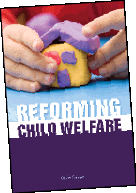 |
Olivia Golden
The Urban Institute Press
300 pages. $29.50 paperback.
“When parents can’t or won’t” keep their children safe, writes Olivia Golden, the public child welfare system is “the last safety net.” Federal law makes child welfare agencies responsible for children’s “safety, permanency and well-being,” which includes permanent homes, as well as physical and emotional health, stability, education and development.
Yet agencies “far too often fail to help,” says Golden.
Overwhelmed with floods of cases, understaffed and poorly managed agencies miss chances to intervene before addicted or disturbed parents abandon, injure or kill their children. Children who make it into the system can be damaged by it, bouncing around endlessly in temporary foster settings. Some are abused by those charged with helping them. As of 2005, Golden reports, ailing child welfare agencies in 30 states were operating under federal or state court supervision.
In 2007, according to the U.S. Administration on Children, Youth and Families (ACYF), 3.2 million hot-line referrals were handled by state child welfare agencies, involving 5.8 million children. Two-thirds were considered worthy of investigation, representing 47 per 1,000 American children. Twelve to 15 of those 47 children were deemed victims of abuse or neglect.
About four children per 1,000 enter foster care each year; six to eight of each 1,000 children live in foster care, with huge variations among states. Youths who grow up in the system have poor prospects; each year between 20,000 and 25,000 leave care at ages 18 to 21.
With a detective’s zeal, Golden investigates what works for successful agencies and why others fail. Her analysis is informed by experience. She was appointed by President Bill Clinton to the U.S. Department of Health and Human Services as commissioner for children, youth and families and as assistant secretary for children and families, with responsibility for Head Start, welfare reform, and child abuse and neglect, among more than 60 programs.
In 2001, Golden became director of the Child and Family Services Agency (CFSA) of the District of Columbia, charged with bringing it out of federal court receivership. Her account of leading the dysfunctional Washington agency out of crisis is a gripping suspense story. When she arrived, 20 children were sleeping in the CFSA office building, foster parents were holding grievance meetings about social workers, and The Washington Post was publishing articles about children dying under city protection.
Golden had just over three months to meet a legal deadline to restructure services, hire new staff, update case records, and “untangle a knot of crises, emergencies, demands and requirements” in an agency rife with failure and public shame.
After meeting the deadline to improve performance on 15 standards, Golden continued to transform agency culture for three years. Improvements included social worker caseloads cut in half, rigorous licensing standards for group homes and an automated information system. Learning from mistakes as well as triumphs, Golden is open about her setbacks and doubts.
After placing Washington’s CFSA in the hands of a new director, Golden became a fellow at the Urban Institute, where she studied other child welfare agencies to prepare this blueprint for reform. Under lawsuits, Alabama and Utah systems took 19 and 16 years, respectively, to reform successfully. What took so long?
One reason that child welfare reform is so difficult, Golden writes, is that entangled repairs cross numerous government departments and local services. Many must work together to meet two main challenges: enhancing parenting to prevent danger to children – or protect children from danger – and supporting healthy childhood development. Child welfare research is so limited that reformers often rely on their own judgment. “Even the most strongly supported findings [such as how children are damaged by multiple placements] are too seldom put into practice,” says Golden.
She clarifies these crucial questions:
• What lessons for reform are revealed in the turnarounds of the child welfare agencies in the District of Columbia, Alabama and Utah?
• What are the 10 essential rules for agency reformers and child welfare leaders aiming “to transform a system?”
• How can cooperation, connections and agency culture change be cultivated to carry reforms through “the front lines” – social workers, caregivers, nurses, therapists, teachers and all others who directly deliver services to children and families?
Golden identifies seven “obstacles in national policy and local politics” that “even the best leaders rarely overcome.” Many of these obstacles are evident in the Washington, D.C., agency’s track record since she left in 2004: The agency is now on its fourth director since her departure, and a judge decreed in 2009 that it was not “ready to stand on its own.” The Washington agency is an example of her statement that reform is “the work of many years, even decades.”
Golden offers recommendations to surmount each obstacle, from investing in stronger delivery of prevention and treatment services to reforming federal financing. But “better policy and more resources” aren’t enough. “Without a clear vision and accountability for results, careful tracking of performance, administrative systems that support the vision, and a political climate that does not scapegoat in case of tragedy, child welfare agencies will still fail many families,” she concludes.
This book offers visionary leadership in a field fraught with crises that affect our society’s most vulnerable children. Golden’s lucid arguments should inspire the next generation of child welfare leaders and involve the public in her mission. (800) 537-5487, http://www.urban.org.





























